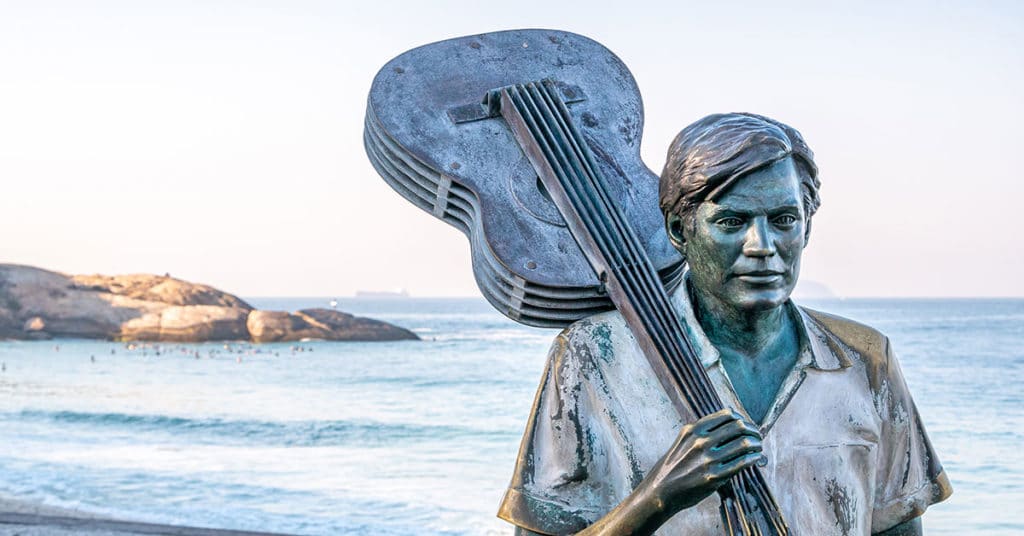Remember Antônio Carlos Jobim, one of the principle founders of bossa nova, who was born in Tijuca, Rio de Janeiro, Brazil on January 25, 1927. 🇧🇷
“Tom” Jobim is one of the primary artists behind the blending of samba and jazz which we call bossa nova. He uses the most beautiful jazz chords. Study Jobim and you’ll not only learn bossa nova, you’ll learn jazz.
This brings up a musical paradox. Latin American and Caribbean artists hear jazz and say that’s our music. American artists hear Latin American and Caribbean music and say that’s our music.
They are all right. Throughout history big human ideas often appear in different parts of the world around the same time. We make the mistake of naming them and claiming them as our own, but big human culture is universal. That’s why it’s big. It makes sense to everyone.
Vinícius de Moraes and Black Orpheus
Jobim starting playing night clubs in Rio in the 1940s. His breakthrough was teaming with lyricist Vinícius de Moraes to score the play “Orfeu da Conceição” in 1956. It set the Greek legend of Orpheus and Eurydice in the favelas (barrios) of Rio.
When the play became the now legendary film “Orfeu Negro” (Black Orpheus), the two wrote three songs, mostly over the telephone. The movie by French director Marcel Camus is famous. It won the Cannes Palme d’Or in 1959 and the Oscar for Best Foreign Language Film in 1960. Today it is remembered mostly for its soundtrack.
Jobim became part of this group of important Brazilian artists and jazz artists, mostly out of New York City.
João Gilberto Was Never Desafinado
“Desafinado” means slightly out of tune. We are jealous that one Portuguese word could carry so much meaning. João, whose style of singing defined bossa nova, was never out of tune, although he was never quite in tune either.
His almost whispered style of singing avoids vibrato so it becomes almost spoken word. You can’t whisper vibrato. The whisper is in the front of the mouth while vibrato comes from the back. The style also emphasizes lip movements to shape the sound which is soothing like the Portuguese language.
But João creates interest by singing a little before or behind the beat. He stretches his words over rhythms in the way that New York rappers will do later. A really great dancer will do this too. It adds an envelope of feeling. The effect gives you the sense of watching the waves coming in from the sea. It’s so relaxing. It’s so Brazil. It’s like your mother caressing you.
João developed his style to suit the limits of microphones at the time. He then advanced recording technology by switching from one microphone to one each for the voice and guitar. We’ve also read of João hiding in the family bathroom to practice because his father was against him singing. The family thought he was insane.
João Gilberto’s first album “Chega de Saudade” defined the bossa nova singing style in 1959. It included Jobim classics “Desafinado” and “Chega de Saudade.” Samba and jazz were mixing in Brazil for a long time, but this album defined bossa nova.
Antônio Carlos Jobim at Carnegie Hall 1962
Tom Jobim played Carnegie Hall in 1962. This historic concert really brought bossa nova to New York City and the world.
Stan Getz The Girl From Ipanema

Jobim is most famous for writing the music to “Garota de Ipanema” (The Girl From Ipanema) with Portuguese lyrics by Vinícius de Moraes in 1962.
“Getz/Gilberto,” the Stan Getz recording with João Gilberto and female vocals by Astrud Gilberto became a global hit in 1965, won multiple Grammy Awards and remains one of the best-selling jazz albums of all time.
Our friend, renowned Brazilian adman Washington Olivetto who famously puts Brazilian music in ads, told us that Brazilian music is the world’s most popular music after the Beatles. This is why.
Both the words and the music of the song perfectly capture the feeling of being young and hanging out on the beach. It puts you on Ipanema (the famous Rio beach) in summer with Pão de Açúcar (Sugarloaf Mountain) overlooking it all.
The song doesn’t get into the complexities of relationship. It’s just about admiring beauty, “Ahhhhhhhh.” And it captures the melancholy feeling of knowing that your youth will eventually fade away with time. That’s Saudade, the Portuguese and Brazilian concept of deep longing when separated from the ones you love.
You are not the only one who wants to book a plane ticket to Rio right now.
There was a real girl from Ipanema. She is Helô Pinheiro. She used to walk on the beach and buy cigarettes from the store. The local boys would admire her. We’re not sure how it is today, but up until at least the mid-2000s, it was culturally appropriate in Brazil to make cat calls. It was almost expected, like getting social media likes. We wouldn’t do it now, but that’s how it was once upon a time in Brazil.
Jobim was a New Yorker Too
Jobim’s bossa nova evolved into MPB, Música popular brasileira, contemporary Brazilian pop music.
The maestro passed away after recording his album “Antonio Brasileiro” in New York City in 1994. He is buried in Cemitério São João Batista in Rio de Janiero.
Even if you don’t know their names, most of us know by heart many of the songs that Antônio Carlos Jobim wrote. “How can he tell her he loves her?”
